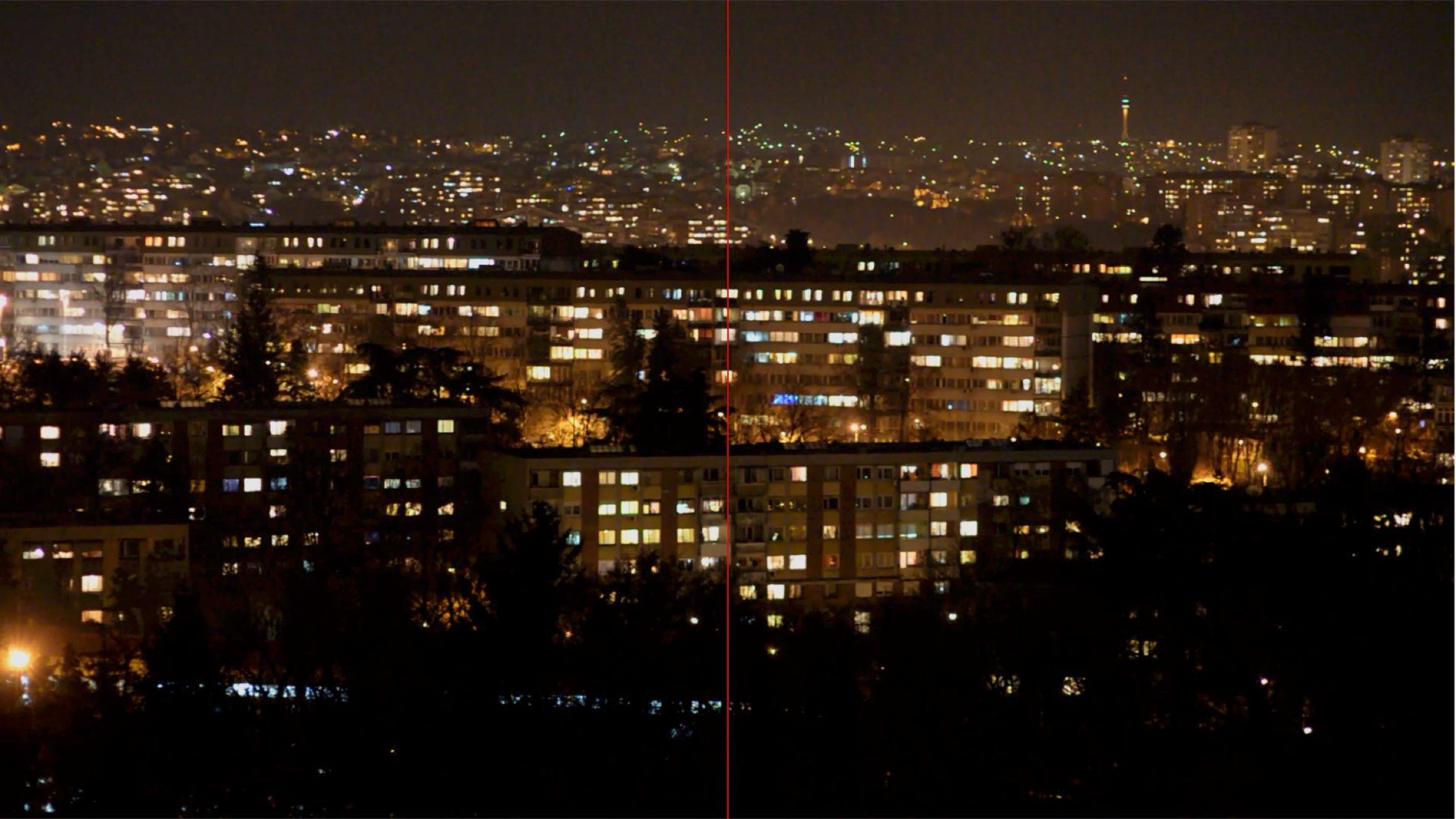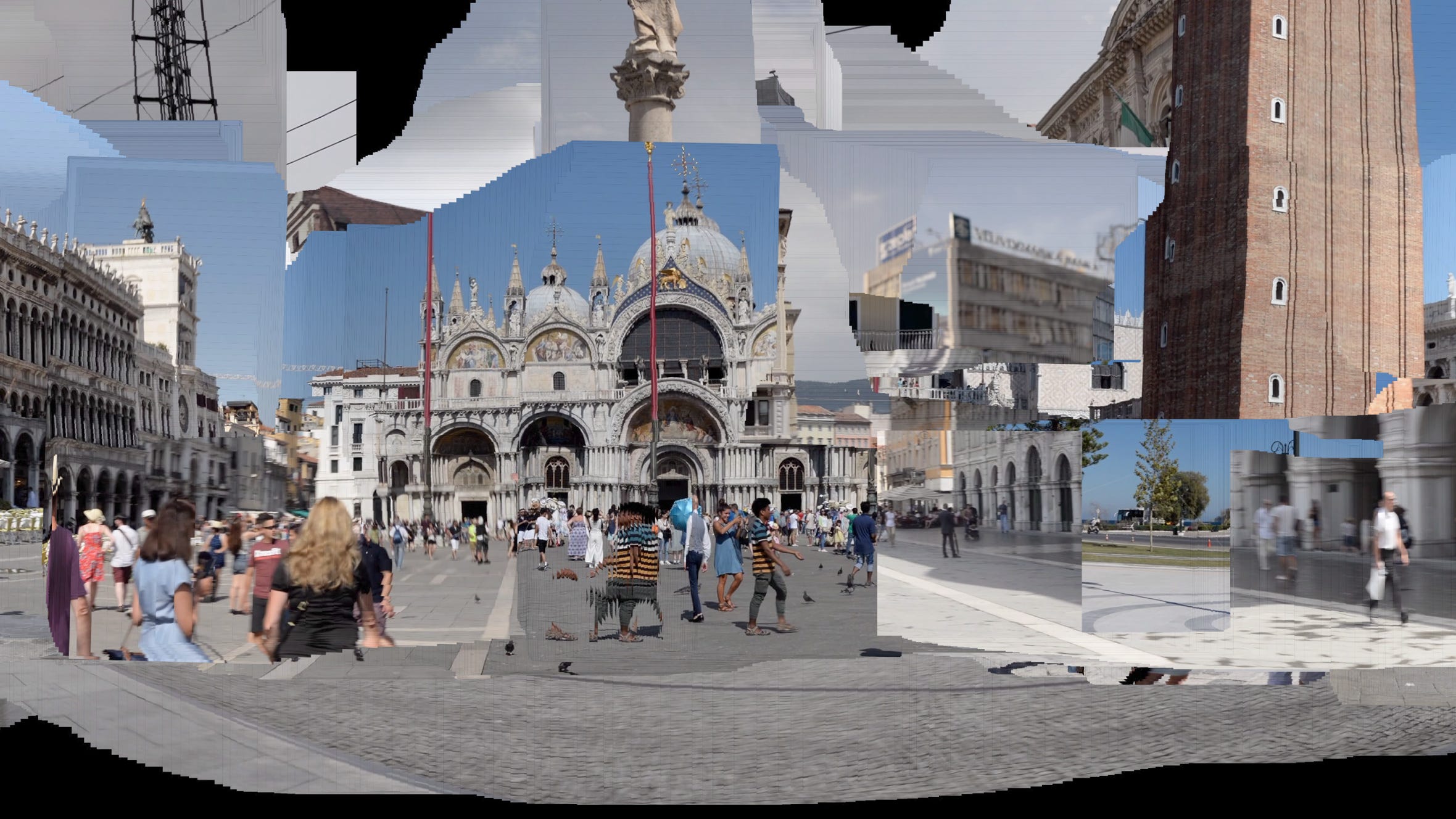Extended Landscape
by Jelena Vojvodic
The Nemanja Ladjic exhibition “Extended Landscape” tries to confronts us with a space, environment or milieu where there are no divisions between the real and digital, online and offline, natural and artificial, city/culture and nature, local and global. The textures we see in the three video installations are destabilized landscapes, regions of intensity, blocks of becoming, which come to us by merging the natural and the artificial. These are programmed and projected landscapes, composites made up of documentary photographs and videos as well of digital elements (hardware-, software- and algorithmic). The narrative of both the exhibition and its exhibits is completely reduced so that the focus can be placed on the problematic of the environment – in terms of the formats (video installations with sound, large projection dimensions, immersion), of content (scenes of the everyday urban flow) and finally, with Ladjic formal action of accumulating and manipulating sensoral data, programming and employing algorithms, which inself problematize the logic of the production of the visible landscapes.
Throughout the exhibition Ladjic invites us to take a system-dynamic, cybernetic view of a space that equally includes human elements and elements of technological infrastructure – by indicating constant exchange and translations between heterogeneous elements and spaces, information flux and affects that organize a single communicational aggregate humans-machines. The exhibition point to spatial and social confusion within this glocal space (“Squares”), as well as to the paradox of simultaneous hypervisibility and invisibility – the state in which we are exposed to the mechanical view or more precisely – to listening by sensors and machines (“Spieluhr”); while, on the other hand, the technological and financial processes of global capital, templates and algorithms that connect us and shape our environment, are becoming less and less transparent, even inaccessible to human understanding (“PopUp” and other).
Traditional research of space in Nemanja Ladjic’s work has been expanded by the introduction of the problematic of the intensive space and especially its territoriality – the consistency that it gains due to instantaneous and global communication supported by internet-connected telematic (computer-telecommunication) infrastructure – by its central (protocolar-), peripheral and relay elements.
In addition to the geometric, visible and measurable space, that we associate with Euclidean geometry and the analogue language – a space which is in Deleuze and Guattari called striated, Ladjic now introduces the problematic of the smooth – mathematical or acoustic space, associated with arithmetic and fractal geometry, intensive topology and non-pulsed time. The smooth space is unlimited, undivided and open; it is a vectorial space in which the digital code language operates with its internalized tensions, making that space, and distribution in it, inaccessible to the human eye. In Deleuze and Guattari, these two spaces are connected with the help of the holey space, that is, the metallic (telematic) line that carries “an affect of the smooth space”.
The interplay and intercommunication of these spaces are the reason why Ladjic, at this exhibition, called “Extended landscape,” treats the urban landscape, the space of the polis and the political, as an open systemic architecture that opens up to the air and cosmic space, and through a “metallic” telematic line links to the global media space. This holey space, in whose production we all participate by using Internet technologies and portable smartphones, is the consistency that allows the constant live stream broadcasting – making matter, affects and human forces translate into data; condemning them to become raw material for placing in remote databases, for statistical and algorithmic processing. The attempt to indicate these mechanisms and procedures, hidden computer and abstract logical layers is reflected in Ladjic’s reduction of the narrative to enable the contemplation of the environment and the tracking the logic of its transformations. In the foreground of the work “Pop-up” we see transformations of the physical scenography of a striated, state-political and city space, while in the continuation of the exhibition, works “Spieluhr” and “Squares” problematize the flows of information in real time, algorithmic operations and manipulation of accumulated digital data. In the work “Spieluhr” this process is indicated by Ladjic's action of translating the data from a striated space to a smooth space. Striated space is treated as a fixed visual template of the city-night landscape from which the sensor extracts events by recording only changes of light in the otherwise fixed landscape. Then, with the help of an algorithm, these visual cues are translated into sound that we hear, that is to acoustic space that surrounds us. Ladjic here shows how information on events become digital and communicative, and how they finally, with a lot of descriptive information (metadata), end up accumulated in a digital archive.
In the work “Squares”, the database/digital archive problematic is coming to the foreground because the accumulated data now become a subject of a new, technologically-enabled, view that talks about new possibilities of machine manipulation and possibilities for reading data-blocks, now within the logic of intensive space. Ladjic reads the recorded digital video blocks using an algorithm to add a new view at the material, now from the perspective of the temporal, rather than the usual spatial axis, and in this framework, follows only changes of the movable elements of the image-block. The blocks that he reads using an algorithm are finally inserted into standard video sequences captured by a camera and morphed together into a unique environment that we see in the exhibition space. Ladjic is showing an environment that is constantly transforming, remaining at the boundary of (aesthetic) naturalness of the appearance of a typical city square, while, and we will notice this while immersed in the installation, our cohesion of the visual representation is really achieved by sound, flowing in real-time around us, that is, it is achieved with the use of smooth space.
*
Finally, it can be concluded that, although Ladjic’s practice implies work with computer installations with projection and techniques of post-production, his research as well as the exhibition setting remain essentially related to his original commitment to sculpture and research into the problematic of space and materiality. At this exhibition, Ladjic makes this problematic more complex and widens it; he does not treat space (only) as a space of architecture, but also introduces the issues of its configuration and structuration, thus bringing to the forefront questions of the territoriality of the smooth space and the process logic of telematic infrastructures and digital archives (databanks). To the political Extensio, as a spatial-temporal framework of the state and, in general, striated political space, he adds the intensive Spatium of global capital; along with the visual space, the space of tactile (haptic) and sonorous (sound) qualities.
Translated by Vesna Strika
The text was published as part of the catalog for the exhibition “Extended Landscape” by Nemanja Ladjic at Cultural Centre Belgrade, 2017.
The original text was reworked by Jelena Vojvodić in 2018.

